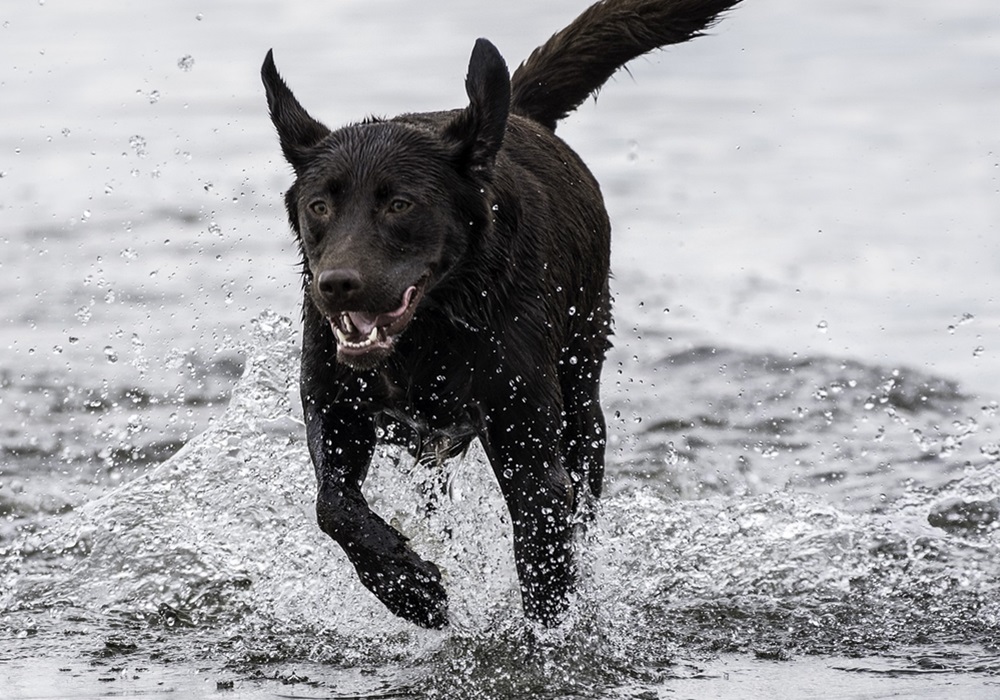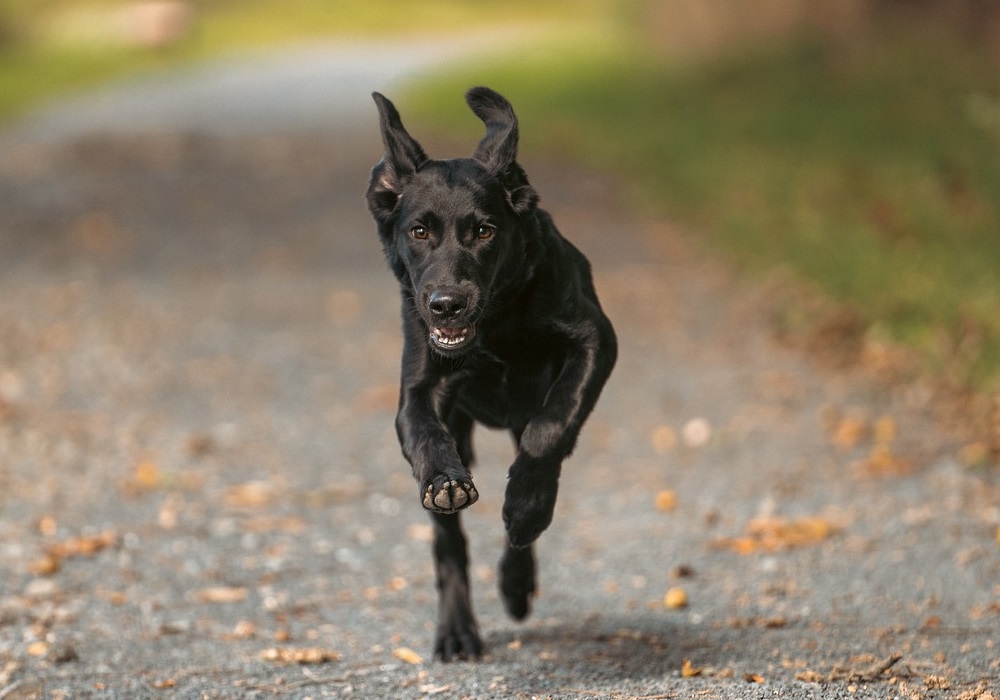
Exercise Induced Collapse (EIC) causes weakness and collapse in some dogs, particularly in very active and excitable dogs. It is caused by a gene mutation affecting some breeds.
If you have a Labrador, Chessie, or any other breed prone to this condition, you'll want to pay close attention. Let's dive into what EIC is, how to spot it, and most importantly, how to keep our dogs safe and healthy.
What is Exercise Induced Collapse?
Exercise Induced Collapse is a genetic condition that affects certain dog breeds, causing them to collapse after intense physical activity.
Imagine playing fetch with your energetic Lab, only to see him suddenly stumble and fall after a few minutes of running. It's a scary sight, but understanding EIC can help us prevent these episodes and help our dogs lead happy, active lives.
Which breeds are most affected?
While EIC is most commonly associated with Labrador Retrievers, it's not exclusive to them. According to UC Davis Veterinary Genetics Laboratory, the breeds that may carry the EIC gene are:
- Australian Cobberdog
- Australian Labradoodle
- Bouvier des Flandres
- Boykin Spaniel
- Cardigan Welsh Corgi
- Chesapeake Bay Retriever
- Cockapoo
- Cocker Spaniel
- Clumber Spaniel
- Curly Coated Retriever
- Deutsch-Drahthaar
- English Cocker Spaniel
- German Wirehaired Pointer
- Labradoodle and other crosses
- Labrador Retriever
- Old English Sheepdog
- Pembroke Welsh Corgi
- Vizsla
EIC can affect both male and female dogs. It can also occur in mixed breeds, such as doodles and dilutes, that have genetics from one of the affected breeds. And it's in both field and show lines.
What does an EIC episode look like?
Picture this: You're at the dog park on a warm summer day. Your Labrador is having the time of his life chasing after his favorite ball. Suddenly, you notice his gait becoming unsteady. His back legs seem weak, and he's struggling to keep up with the other dogs. This could be the beginning of an EIC episode.
Key symptoms to watch for include:
* A rocking or wobbly gait
* Weakness in the hind legs
* Dragging of the back legs while still running with the front legs
* Collapse after 5-15 minutes of intense exercise
It's important to note that these episodes are often triggered by a combination of factors, not just exercise alone. High excitement, stress, and warmer temperatures can all contribute to an EIC episode.
The science behind Exercise Induced Collapse
EIC is caused by a specific gene mutation. For a dog to be affected, both parents must carry at least one copy of the gene. Interestingly, about 30% of tested Labradors carry this gene. That's why genetic testing is important for breeding programs and for pet owners who want to be proactive about their dog's health.
I use DDC for testing because they're fast, helpful, and they don't charge for tests that aren't a problem for Labradors. They also show the results in plain English. For example:

If you use a different laboratory, they may report the results as N/N, or N/EIC, or EIC/EIC.
For results that are N/N, the dog won't collapse due to EIC and won't transmit an EIC gene to puppies.
If the test results are N/EIC, the dog won't collapse, but can pass the gene on to puppies.
Or if the test results are EIC/EIC, the dog may collapse at some point.
Preventing EIC episodes
To keep your EIC-prone dog safe:
- Avoid strenuous exercise in warm weather
- Stop all activity at the first sign of weakness
- Stick to mild or moderate exercise for affected dogs
- Consider removing high-energy, excitable dogs from intense training programs
Our dogs still need exercise and mental stimulation, but we need to be mindful of their limits.

Image by Yinan Chen from Pixabay
What to do during an EIC episode
If you suspect your dog is having an EIC episode, stay calm and follow these steps:
- Immediately stop all exercise
- Move your dog to a cool, shaded area
- Offer small amounts of water
- Lightly spray your dog with cool (not cold) water if they seem overheated
- Allow your dog to rest and recover gradually
Most dogs are alert, but may seem confused. Some dogs may still try to run and their front legs might be stiff. Or they may not be able to move their head and legs. They don't seem to be in pain. Body temperature is often high.
Symptoms may worsen for a few minutes, but after 10-20 minutes the dog should start returning to normal. It may take longer for their body temperature to return to normal.
The good news is that most dogs recover from EIC episodes within 5-25 minutes, with no lasting effects. However, it's always best to consult with your vet after an episode to ensure there are no underlying issues.
Living with an EIC-prone dog
Having a dog with EIC doesn't mean they can't enjoy an active lifestyle. My friend Debbie has a Labrador named Tucker that was diagnosed with EIC. At first, she was worried that Tucker's days of fetch and swimming were over. But with some adjustments, Tucker still leads a fun, active life.
Debbie found that shorter play sessions, indoor games during hot weather, and swimming were great ways to keep Tucker happy and healthy. She also learned to read Tucker's body language, knowing when to call it quits before an episode could occur.
There are other problems with similar symptoms:
Overheating (this can be an emergency)
- frantic panting, increased heart rate, extreme drooling, labored breathing, bright red membranes
- may be dizzy and appear confused
- may collapse and/or experience seizures
- may vomit and/or have diarrhea
Centronuclear Myopathy (CNM)
- gait abnormalities
- generalized weakness
- tires easily
- muscle wasting
- symptoms usually develop as a puppy (2-5 months old)
- once the symptoms develop they are almost constant
If you'd like more information about CNM, go to What is CNM in Labradors?

Image by Joshua Choate from Pixabay
FAQs About Exercise Induced Collapse
Q: Can EIC be cured?
A: There's no cure for EIC, but it can be effectively managed through lifestyle adjustments and careful monitoring.
Q: How is EIC diagnosed?
A: EIC is typically diagnosed through genetic testing and observation of symptoms during exercise.
Q: Will my dog with EIC have a shorter lifespan?
A: EIC itself doesn't typically affect a dog's lifespan if properly managed.
Q: Can dogs with EIC still participate in dog sports?
A: While high-intensity sports might be off the table, many dogs with EIC can still enjoy low-impact activities and modified training programs.
Exercise Induced Collapse is a manageable condition that doesn't have to drastically alter your dog's quality of life. With awareness, prevention, and proper care, our EIC-prone pups can still lead happy, active lives.
Knowing how to prevent and possibly deal with an episode can keep your dog healthy and safe. So, the next time you're at the dog park or out for a hike with your dog, keep these insights in mind. Your dog will thank you for it!
NOTE: The information on this website is not intended to replace your veterinarian's advice. This information is intended to provide non-technical information in an easy-to-understand format. The website author accepts no responsibility or liability for how this information may be interpreted or construed, or any actions that might be taken as a result of the information herein.


